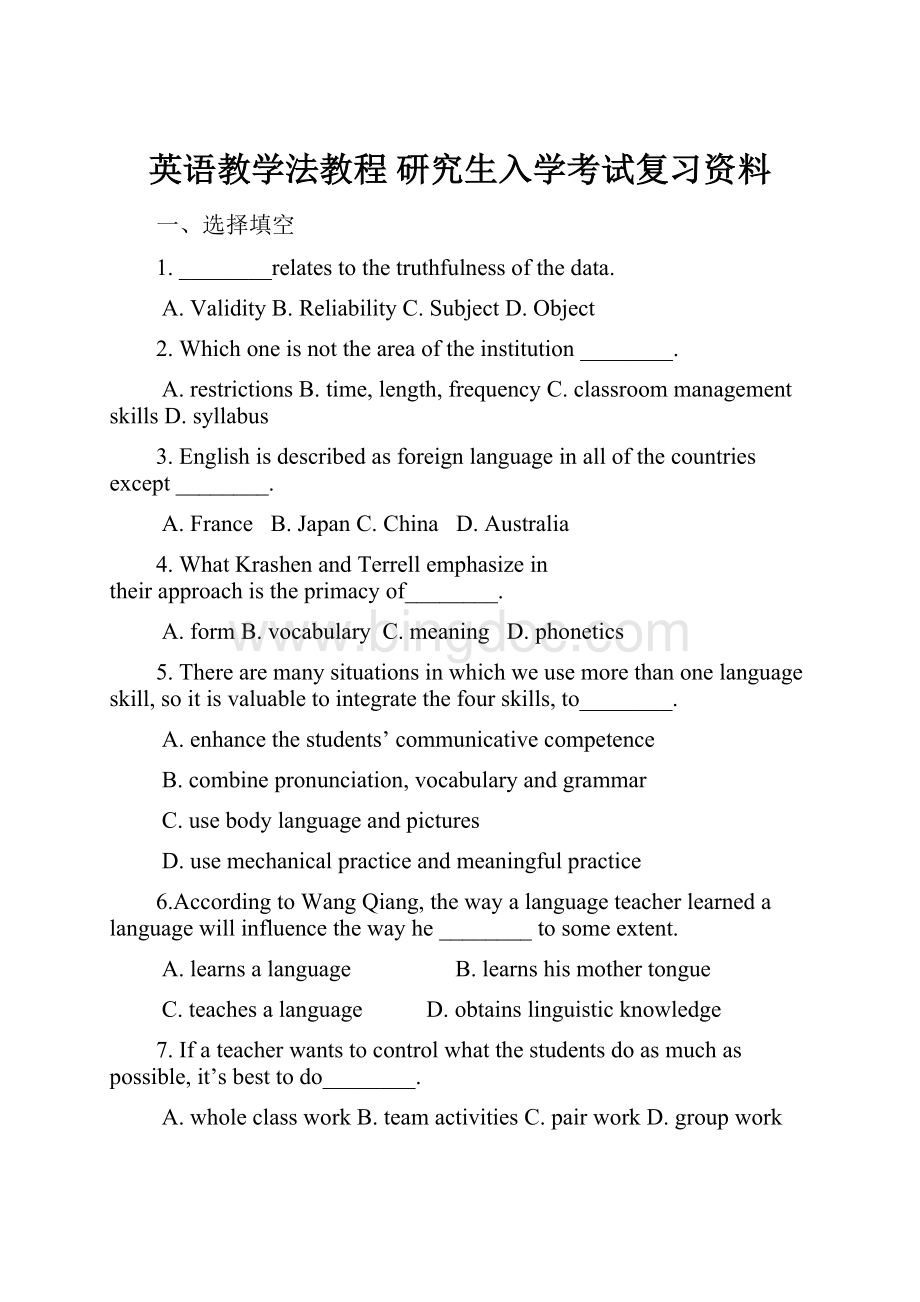英语教学法教程 研究生入学考试复习资料.docx
《英语教学法教程 研究生入学考试复习资料.docx》由会员分享,可在线阅读,更多相关《英语教学法教程 研究生入学考试复习资料.docx(17页珍藏版)》请在冰点文库上搜索。

英语教学法教程研究生入学考试复习资料
一、选择填空
1.________relatestothetruthfulnessofthedata.
A.ValidityB.ReliabilityC.SubjectD.Object
2.Whichoneisnottheareaoftheinstitution________.
A.restrictionsB.time,length,frequencyC.classroommanagementskillsD.syllabus
3.Englishisdescribedasforeignlanguageinallofthecountriesexcept________.
A.FranceB.JapanC.ChinaD.Australia
4.What Krashen and Terrell emphasize intheir approach is the primacy of________.
A.formB. vocabulary C. meaning D. phonetics
5.Therearemanysituationsinwhichweusemorethanonelanguageskill,soitisvaluabletointegratethefourskills,to________.
A.enhancethestudents’communicativecompetence
B.combinepronunciation,vocabularyandgrammar
C.usebodylanguageandpictures
D.usemechanicalpracticeandmeaningfulpractice
6.AccordingtoWangQiang,thewayalanguageteacherlearnedalanguagewillinfluencethewayhe________tosomeextent.
A.learnsalanguage B.learnshismothertongue
C.teachesalanguage D.obtainslinguisticknowledge
7.Ifateacherwantstocontrolwhatthestudentsdoasmuchaspossible,it’sbesttodo________.
A.wholeclassworkB.teamactivitiesC.pairworkD.groupwork
8.Withregardtosyllabusdesign,theCommunicativeApproachlaysspecialemphasison________.
A.authenticmaterialsB.learners’needsC.meaningfuldrillsD.teachers’roles
9.Thegenerative-transformationalschooloflinguisticsemergedthroughtheinfluenceof_________.
A.NoamChomskyB.J.Piaget
C.D.AusubelD.J.B.Bruner
10.Accordingtothebehaviorist,a_________isformedwhenacorrectresponsetoastimulusisconsistentlyrewarded.
A.meaningB.word
C.habitD.reaction
11.AnotherlinguistictheoryofcommunicationfavoredinCommunicationLanguageTeachingis_________functionalaccountoflanguageuse.
A.Chomsky’sB.Hymes’s
C.Candlin’sD.Halliday’s
12.WhatKrashenandTerrellemphasizeintheirapproachistheprimacyof_____.
A.formB.vocabulary
C.meaningD.phonetics
13.TheultimategoaloflearningaforeignlanguageinaGrammar-Translationclassroomistoenablethestudentsto______itsliterature.
A.translateandwriteB.read
C.readandwriteD.readandtranslate
14.TheNaturalApproachbelievesthattheteachingof______shouldbedelayeduntilcomprehensionskillsareestablished.
A.listeningB.speaking
C.readingD.writing
15.ManyproponentsoftheCommunicativeApproachadvocatetheuseof_______materialsinthelanguageclassrooms.
A.classicB.authentic
C.modernD.oral
16.Ofthethreeproceduresfollowedinacognitiveclassroom,whichcanbeviewedastheperformancestage?
A.Exercises.B.Applicationactivities.
C.Introductionofnewmaterials.D.Noneoftheabove.
17.Fromthemid-1970sthekeyconceptineducationallinguisticsandlanguagepedagogyisthatof_______.
A.Communicationorcommunicativecompetence
B.motivationinlearningaforeignlanguage
C.independenceandautonomyinlearning
D.languageacquisitionthroughtheuseofactivetrial
18.To_______,itisadvocatedthatweadoptacommunicativeapproachtowriting.
A.motivatestudents B.demotivatestudents
C.freestudentsfromtoomuchwork D.keepstudentsbusy
19.AccordingtoWillistheconditionsforlanguagelearningareexposuretoarichbutcomprehensiblelanguageinput,useofthelanguagetodothings,_______toprocessandusetheexposure,andinstructioninlanguage.
A.chances B.context C.motivationD.Knowledge
20.Asfarasschoolassessmentisconcerned,wehaveteacher’sassessment,continuousassessment,_______,andportfolios.
A.students’self-assessment B.relative’s assessment
C.informalassessment D.formalassessment
21.Formostpeopletheterm“curriculum”includesthoseactivitiesthateducatorshavedevisedfor_________,whicharerepresentedintheformofawrittendocument.
A.teachersB.designersC.LearnersD.students
22._________istheauthorofthebookSyntacticStructures.
A.EdwardSapirB.NoamChomskyC.J.R.FirthD.M.A.K.Halliday
23.Traditionalbehavioristsbelievedthatlanguagelearningissimplyamatterofimitationand_________formation.
A.learningB.habitC.practiceD.knowledge
24.Theterm"interlanguage"wasfirstcoinedbytheAmericanlinguist,_________.
A.NoamChomskyB.BloomfieldC.B.F.SkinnerD.Larry,Selinker
25.Accordingtotherecordsavailable,humanbeingshavebeenengagedinthestudyoflanguagefor_________centuries.
A.10 B.15 C.20 D.25
26.Viewsonlanguageand_________bothinfluencetheoriesonhowlanguageshouldbetaught.
A.viewsonlanguagelearning B.viewsonculturelearning
C.valuesoflife D.stylesoflife
27. Oneofthedisadvantagesoftraditionalpedagogyis_________.
A.thelearnersareabletouseallskills,includingthereceptiveskillsandtheproductiveskills
B.thelearnersarenotabletousethelanguageinanintegratedway
C.thelearnersarenotabletowrite
D.thelearnersperformwellinclass,buttheycannotreadoutofclass
28.Ifyouaskstudentstotranslatethemeaningofnewwords,youare_________.
A.checkingspellingB.checkingmemorizingC.checkingpronunciationD.checkingunderstanding
29.Krashenbelievesthatacquisitionofalanguagereferstothe_________processleadingtothedevelopmentofcompetenceandisnotdependentontheteachingofgrammaticalrules.
A.consciousB.unconsciousC.overconsciousD.subconscious
30.Inthe19thcentury,thestrategyinlanguageteachingusuallyadoptedbyforeignlanguageteacherswasthe_______ofgrammarruleswithtranslation.
A.introductionB.interpretation
C.comprehensionD.combination
31.Krashenbelievesthatacquisitionofalanguagereferstothe_______processleadingtothedevelopmentofcompetenceandisnotdependentontheteachingofgrammaticalrules.
A.consciousB.unconscious
C.overconsciousD.subconscious
32.Hallidayadvocatesthatthesocialcontextoflanguageusecanbeanalyzedintermsofthefield,tenorandmodeof_____.
A.contextB.discourse
C.contentD.situation
33.IntheNaturalApproach,theteachercanmakeuseofvariouswaysexcept_____inordertohelpthestudentstobesuccessful.
A.keepingtheirattentiononkeylexicalitems
B.explaininggrammaticalrules
C.usingappropriategestures
D.usingcontexttohelpthemunderstand
34.AccordingtoPalmerandsomeotherlinguistsofhistime,______playedoneofthemostimportantrolesinforeignlanguagelearning.
A.grammarB.phonetics
C.vocabularyD.rhetoric
35.______referstotheinterpretationofindividualmessageelementsintermsoftheirinterconnectednessandofhowmeaningisrepresentedinrelationshiptothetext.
A.GrammaticalcompetenceB.Sociolinguisticcompetence
C.DiscoursecompetenceD.Strategiccompetence
36.Students’mistakesare________correctedintheclassroomsoftheDirectMethod.
A.neverB.immediately
C.seldomD.carelessly
37.________isparticularlyinterestedintherelationshipbetweensentencesandthecontextsand
situationinwhichtheyareused.
A.TransformationalGrammarB.Pragmatics
C.StructuralismD.TheSituationalApproach
38.Whatdothethreeapproaches(theSilentWay,CommunityLanguageLearning,andSuggestopaedia)haveincommon?
A.Allstresstheintrusionoftheteacherintothelearningprocess.
B.Alllayemphasisontheindividualandonpersonallearningstrategies.
C.Allviewthelearningofasecondlanguagethesameasthelearningofthefirst.
D.Allthreearedeductiveintheinitialstageofthelanguagelearningprocess.
39.InEnglishteachingclassroomsveryoftenwritingisseenas“writingaslanguagelearning”,anditisbelievedtobe_______.
A.writingforcommunication B.writingforrealneeds
C.pseudowriting D.authenticwriting
40.WhichofthefollowingisNOTamongthefeaturesofprocesswriting?
A.Helpstudentstounderstandtheirowncomposingprocess.
B.Letstudentsdiscoverwhattheywanttosayastheywrite.
C.Encouragefeedbackbothfrombothteacherandpeers.
D.Emphasizetheformratherthanthecontent.
41.Whichofthefollowingistrueofsecondlanguagelearning?
A.Naturallanguageexposure.
B.Informallearningcontext.
C.Structuredinput.
D.Littleerrorcorrection.
42.Whattypeoflearnerscanbenefitmostfromrealobjectinstruction?
A.Individuallearners.
[5.Tactilelearners.
C.Auditorylearners.
D.Visuallearners.
43.Whattypeofintelligenceiscooperativelearningbestsuitedfor?
A.Interpersonalintelligence.
B.Intrapersonalintelligence.
C.Logicalintelligence.
D.Linguisticintelligence.
44.Whatdoesthefollowingpractise?
*PeerandIv.venttothecinemayesterday.
Peterand*Iwenttothecinemayesterday.
PeerandIzoenttothe*cinemayesterday.
PeerandIzoenttothecinema*yesterday.
A.Stress.
B.Articulation.
C.Liaison.
D.Intonation.
45.Whatlearningstrategycanthefollowinghelptotrain?
Matchtheadjectivesontheleftwiththenounsontheright.
HcavyDay
NiceBaby
CloseBuilding
LightRain
TallFriend
CuteSmoker
A.Grouping.
B.Collocation.
C.Imitation.
D.Imagery.
46.Whichofthefollowingisacommunicationgame?
A.Bingo.
B.Wordchain.
C.Rearranginganddescribing.
D.Cross-wordpuzzle.
47.Whichofthefollowingcanhelptrainspeaking?
A.Listenandfollowinstructions.
B.Simonsays.
C.Pairsfi